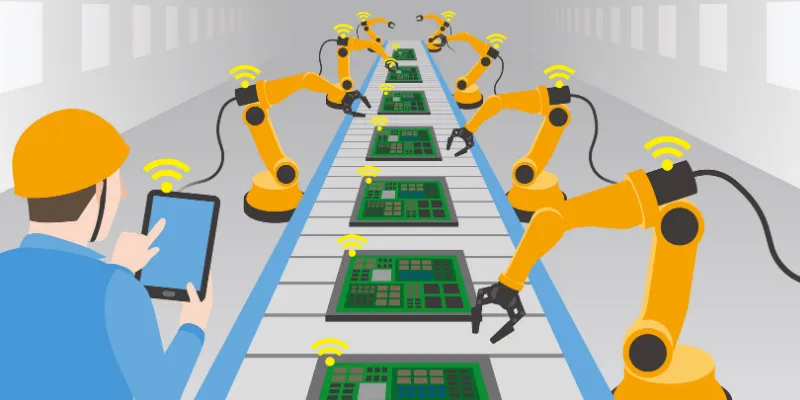Why India’s manufacturing sector will pave the way for Aatmanirbhar Bharat
While we aim to become the world's third-largest economy, the government has set the right tone with the Aatmanirbhar Bharat campaign, but it needs to underline the clear way forward and address a few challenges.
India is going to become the most populous country sometime during the next decade. One-sixth of the world’s population would be living on only four percent of its collective GDP, which means there will be many poor, jobless, homeless, diseased, and hungry people. This isn’t a very pretty picture for a nation that aims to be a $5 trillion economy in the coming few years.
This scenario clearly spells out the need for Indians to earn more, eat better and live richer. The benefits of business and economy need to trickle down. That would happen only if a balanced prism of all three sectors of the economy can be formed – agriculture to feed the masses, manufacturing to provide jobs, and services to envelope the other two.
From being an agrarian economy, India jumped to a services dominant economy, giving core manufacturing a miss. While there were some gains in the process, a vast majority of Indians never tasted the fruit of economic success as the manufacturing sector didn’t record the growth that was expected. For a country as large and diverse as India, it is important that a solid base of manufacturing is needed to urbanise the country and reduce the dependence on agriculture.
Focus on value-added manufacturing
Value-added manufacturing is the need of the hour. Electronics, e-vehicles, consumer durables and household goods present an opportunity not only for the domestic market but also for exports.
The first thing required is a robust vendor ecosystem in India. A lot of things could be manufactured but the components industry needs to be addressed. Buying components from China and assembling them in India would not serve the purpose. However, till such time as a local components industry could be set up, CKD or component import must be allowed with reasonable import duty, while regularly increasing the duties on finished goods under a clearly outlined three-year policy.
This would avoid rude shocks to businesses, and enable brands to plan their manufacturing journey. It is normal that once the assembly begins in India, the manufacturer begins to indigenise components as well.
However, global competitiveness would come only with a well-planned and properly executed components ecosystem, a multi-tiered industry that would feed into the value chain.
A similar approach has enabled the automotive industry in India to develop a strong base of vendors and become globally competitive. This needs to be replicated across sectors.

The big leap
The journey to becoming completely Aatmanirbhar is a long one. Forcing it down on private enterprise by putting punitive duties or non-monetary blockages on imports may be counter-productive. It will actually harm growth prospects of Indian brands, as well as put the consumers into a bind. Indian brands add value to the Indian economy, even if they are being partially or fully manufactured abroad.
The case of Apple is an interesting one in this context, and easy to understand. Almost all of Apple products are made in Asia, and yet, it is the world’s most valuable company by market capitalisation. This is because the real value added is in marketing and branding.
Let’s take an example. An Indian brand that would import a product for an FOB price of Rs 100, would eventually sell to the consumer at a price of Rs 400. Here is how it stacks up. The duty on the item is 20 percent, so Rs 20 go straight to the Indian exchequer. Distribution margins are about 35-40 percent, which provide employment to various strata of the society — right from wholesalers to distributors to shopkeepers and their salespersons. An average rate of GST of 18 percent on the sales price of Rs 400 ensures another Rs 72 in taxes. A PBT of about 15 percent ensures further 5 percent in taxes with 10 percent remaining as PAT. Thus the total tax collected by the government right from import duty to income tax to GST is over Rs 100. This is almost the same amount as the actual import value of the product itself. Every Rs 100 worth of consumer product is thus adding another Rs 300 in the economy, and generating Rs 100 in taxes.
The math is thus heavily stacked in favour of creating markets and increasing consumption, rather than stifling it through artificial blockages on imports. A graded increase of import duties from 20 percent to 33 percent on finished products over the next three years would work best in import-substitution. As Indian brands continue to indigenize and generate manufacturing jobs, they would become stronger and more successful as well.

Role of the government
Gone are the days when the Indian government used to run businesses ranging from airlines and telephony to watches, chemicals, scooters, and steel and aluminium. The government must, however, play a role in aligning factors of production for some critical industries where India could achieve global scale like speciality chemicals, API’s and defence, especially since the world is looking at China plus One policy for their alternative supply points. Public-private partnerships in some sectors that require huge investments would also help achieve global scale quickly.
The role of private enterprise in this journey is going to be most critical. They have to play the game like never before and think big.
However, the government must play its role in providing confidence to the private sector that manufacturing initiatives would be supported and rewarded. The ways in which this could be done are multifarious — ranging from tax breaks to providing land banks, however, the most critical thing is to provide a supportive bureaucratic framework that would facilitate rather than hinder manufacturing setups.
The old thinking has been that private enterprise might misuse national resources to line its own pockets and hence, must be controlled or even discouraged. Economists would clarify that only when national resources are used as factors of production, do they contribute positively to the GDP of a nation. A promoter may make handsome profits but in order to do so, he would have to provide jobs and growth opportunities to thousands of workers, would have enriched numerous distribution partners, and even the government itself in the form of direct and indirect taxes.
Partnerships with domain experts are going to be critical in this journey as India must not try to reinvent the wheel given the short window of opportunity. There are industry experts and customer organisations in the western world that are behind the incredible growth of China over the last three decades through the transfer of capital and technology. Even the government must encourage this in the form of an ever-growing series of structured and result-oriented trade meets and business delegations. Our missions abroad must passionately play the role of trade missions and not political ones alone. From a control mindset, the government would have to move towards a facilitating mindset.
On its part, the private sector has to invest in R&D to create proprietary products and technologies. While the example of Apple is interesting, if we do not invest in our own tech, we will end up like some of the Indian mobile phone brands that made hay with cheap Chinese imports but were shunted out of the market once the Chinese entered our markets with their own brands. It is absolutely critical to groom tech and product-design talent, create research labs, and reward innovation. Filing of patents must be made easier, and the protection of IPR has to be made mandatory.
Filling in the gaps
While the government is doing its part and there is still a lot of room for improvement, even the private citizen needs to have a change of mindset. Clean financial operations are a must.
Firms that try to make a quick buck by compromising on the quality of ethics will not grow in today’s world connected with ratings, reviews and social media.
Most of the manufacturers are stuck in the old ways and refuse to accept that quality is not a differentiator; it is the price of entry in the global market. Some manufacturers who do good quality work and are able to export to international markets, are unwilling to sell in the domestic markets. They love their easy dollar income and do not wish to face the dust and grime of India. However, they would do well to remember that no company anywhere in the world has become successful in scaling up globally if it has not tapped domestic potential.
Building a world-class manufacturing base is thus going to be a result of a partnership between all players – public and private. Everyone must do their honest part in ensuring that the youngsters of today can find jobs and have at least some semblance of normal economic life. Being a strong economic power is also critical for the nation's safety and security, given the turmoil in the current geopolitical environment. We are starting at a low base. We can achieve 11-12 percent YOY growth, and if we do that, we can reach the $5 trillion dream by 2025, and be a relevant player in the world economy.
The way forward
A central organisation like NITI Aayog needs to take this up, interact with the industry bodies, study the megatrends, correlate these with imports and exports data, identify the components to be made in India, share the findings with the industry towards creating this ecosystem, and influence policy towards making it a success.
A cluster approach that has been used very successfully earlier in Europe and later in China, would be useful but requires coordinated planning. Individual efforts at a small scale would not lead us to global scale output.
Ravi Saxena is the Managing Director of , a kitchen, cookware, and serveware brand.
Edited by Kanishk Singh
(Disclaimer: The views and opinions expressed in this article are those of the author and do not necessarily reflect the views of YourStory.)










